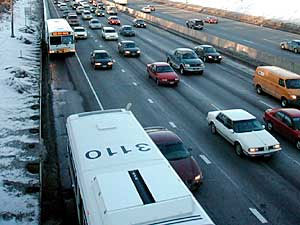Photos
More from MPR
Resources
Respond to this story
| ||||||||||||||||||||||||||||||||
The next big Twin Cities transit debate
November 21, 2004
 |
| Shoulder bus lanes, a major bus rapid transit feature, have been used in the Twin Cities for 11 years. (MPR photo/Dan Olson) |
St. Paul, Minn. — First the pricetags. An 11-mile long bus rapid transit or BRT system between the two downtowns would run mostly down the middle of University Ave., and cost about $240 million.
An 11-mile long light rail line, including a tunnel underneath the University of Minnesota's Minneapolis campus would cost about $840 million -- more than three times more than a bus rapid transit system.
However, Metropolitan Council chairman Peter Bell says bus and rail don't exactly make for an apples to apples comparison.
 | |||
"(The) shelf life of a rail system is longer than high speed bus, and operating costs are somewhat lower," he says.
In addition, Bell says, a rail system carries more people than a bus system. So light rail's annual operating costs fare better than bus -- but not favorably enough, Bell says, to bridge the huge difference in construction costs.
Bus rapid transit's appeal is the relatively low upfront cost. Most of the service can go down the middle of the street without tearing it up to lay rail. Paint some new lines, buy some buses, hire drivers and support staff and the system is ready.
Ramsey County Commissioner Susan Haigh says the downside is congestion. Buses will vie for roadway space along some portions of the route with traffic, and everyone will end up waiting.
"Bus rapid transit basically breaks down because of congestion in the downtowns, and at the University of Minnesota," Haigh says.
 | |||
One solution is a true bus rapid transit system. That's where buses have their own lane separate from other traffic. But that requires buying more land or right of way, which pushes the cost of BRT far higher.
Business and neighborhood groups along University Ave. in St. Paul have been bouncing transit ideas back and forth for years. St. Paul's business community is on record favoring a light rail line.
Travis Snider, a homeowner in the Snelling-Hamline area, is a community council board member and the immediate past president of the neighborhood group. He says the neighborhood council favors light rail.
"The fear is a busway would not do enough to alleviate the congestion, and would simply be more of a cosmetic makeover rather than a real solution," Snider says.
|
The fear is a busway would not do enough to alleviate the congestion, and would simply be more of a cosmetic makeover rather than a real solution.
- Travis Snider, resident of the Snelling-Hamline area |
A decision on what will happen is drawing near. In the next week or so, the federal government is expected to release the environmental impact statement on transit in the central corridor. It will also release its estimate of which option -- bus or rail -- makes more economic sense.
Then, sometime around Jan. 1, 2005, the Met Council will likely make its recommendation based on the federal government's findings.
The Met Council recommendation will also be based on another key consideration -- money. The federal government is willing to pay half the construction cost of a Central Corridor transit service. The other half must be paid by the state.
Competition for state transportation dollars is fierce. Rural, urban, road and transit forces are in a political gridlock over what to build and where to find the money.
One way to help break the gridlock, some argue, is to pass a Twin Cities regional sales tax. Another is to increase the state gasoline tax. Money from either, or both, would help fund additional lanes and new transit service in the region.
Peter Bell says the governor has told him a metropolitan area sales tax is not acceptable.
"That's going to be very difficult to make it through both (state legislative) bodies and get the signature of the governor. The governor believes, and frankly, I agree with him, that we in Minnesota are not undertaxed," Bell says.
State lawmakers play the key role in selecting a mode of transit in the Central Corridor. Last session they couldn't agree on a bonding bill. This session Central Corridor transit supporters will be back asking for money to pay for the preliminary engineering for either bus or rail.
Lawmakers face growing pressure from all quarters to address a state transportation funding system that has fallen behind what many feel is required to handle the state's population growth.
|
News Headlines
|
Related Subjects
|

